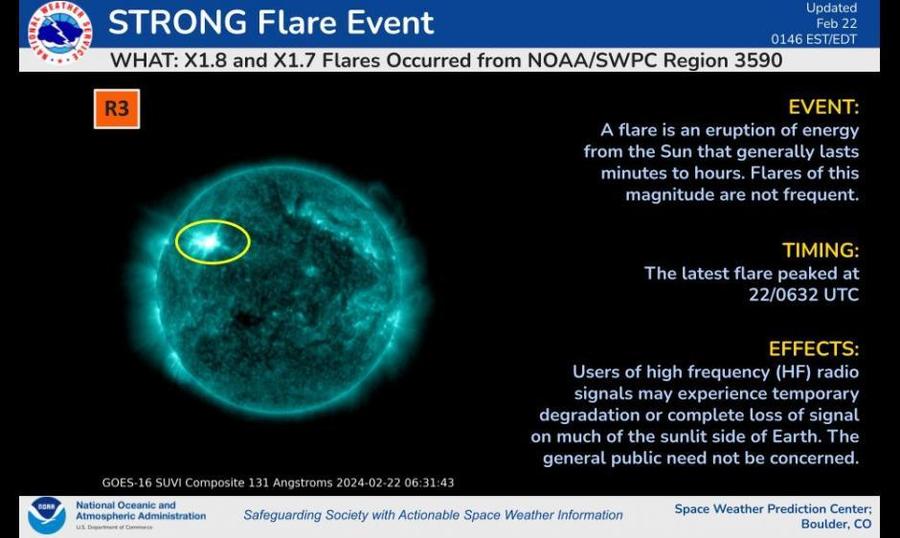
Are solar flares not real, thus incapable of disrupting telecommunications networks, as a post on Instagram suggests? No, that's not true: Solar flares are well-documented bursts of electromagnetic energy emitted by the sun during geomagnetic storms, and a large body of evidence proves they exist and have far-ranging effects. Flares disrupt radar, gps and other radiowave-based systems, according to recognized experts at the National Oceanic and Atmospheric Administration (NOAA). Those affects depend on the intensity of each flare. It is, however, unlikely that the high-intensity solar flares that occurred on February 21 and 22, 2024, contributed to widely reported cellular network outages, as one news report suggested. Network operators attributed it to a terrestrial force: human error.
The claim originated in a post shared on Instagram on February 22, 2024, (archived here) with a caption that read:
Please tell us more about "space weather."
Below is how the post appeared at the time of the publication of this fact check:
(Source: Instagram screenshot taken Fri Feb 23 09:19:34 UTC 2024)
The video was posted on February 22, 2024 -- the same day that a nationwide outage of telecommunications systems occurred in the U.S. The post implied that the outage couldn't have been caused by a solar flare because such a phenomenon doesn't exist.
Lead Stories traced the screenshots shared in the video on Instagram to a post on X from February 22, 2024, (archived here). Its caption read:
🚨And here it is folks! The cellular outage was caused by SPACE WEATHER! Wow makes total sense.......
Next, Lead Stories conducted a reverse image-search (archived here) using a screengrab from the video on Instagram and identified the anchor as meteorologist Emily Sutton of Oklahoma's News 4 (call letters KFOR). A search of the station's website revealed a February 22, 2024, report titled, "How solar flares could impact communications on Earth" (archived here). In the roughly one-and-a-half-minute-long clip, Sutton suggested solar flares may have caused the outage. She said:
If you're experiencing [a cell phone outage] it may be the result of space weather...
There was a strong solar flare event that happened just after midnight and they actually captured an image of it right here.
Another reverse image-search (archived here) using the image shared in the newscast revealed that the National Weather Service (NWS) originally posted it (archived here) on February 22, 2024, the day of the outage.
(Source: National Weather Service)
February 2024 solar flares did not impact telecommunications systems
Two solar flares were announced in a bulletin (archived here) published by NWS. The first occurred on February 21, 2024, at 6:07 pm EST, and the second on February 22, 2024, at 1:32 am EST.
The flares were rated "R3" on a scale from R1 to R5, the latter being the most intense. R3 is described on the NOAA space weather scales (archived here) as a strong level that can impact:
Biological: Radiation hazard avoidance recommended for astronauts on EVA; passengers and crew in high-flying aircraft at high latitudes may be exposed to radiation risk.
Satellite operations: Single-event upsets, noise in imaging systems, and slight reduction of efficiency in solar panel are likely.
Other systems: Degraded HF radio propagation through the polar regions and navigation position errors likely.
This means that in some parts of the world, disrupted radio communication systems may have occurred, as the NWS said:
Users of high frequency (HF) radio signals may experience temporary degradation or complete loss of signal on much of the sunlight side of Earth. The general public need not be concerned.
However, NWS assured readers that it was "highly unlikely that these flares contributed to the widely reported cellular network outages." AT&T confirmed (archived here) on February 22, 2024, that the outage was likely caused by "application and execution of an incorrect process used as we were expanding our network," or a coding error.
Space weather is a genuine phenomenon
Simply put, space weather is activity on the sun's surface. Located 93 million miles from Earth, the sun is a dwarf star (archive here) made up of gases and electromagnetic energy. This energy can sometimes create a solar storm and, within it, solar flares, according to NASA (archived here). Solar flares are described by NOAA's Space Weather Prediction Center (archived here) as "large eruptions of electromagnetic radiation from the sun lasting from minutes to hours."
Flares are associated with active regions, or sun spots, where the magnetic fields are strongest. They occur when magnetic fields in and around the sun reconnect, according to NASA (archive here).
Solar flares can travel at the speed of light, emitting radiation from the sun that can sometimes damage satellites or cause radio blackouts. Though solar storms can cause damage to communication systems, this typically only effects radio systems, according to NASA Jet Propulsion Lab (archive here).
Additional Lead Stories fact checks of claims related to solar flares can be found here.

















